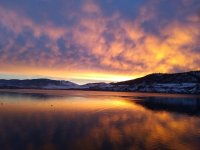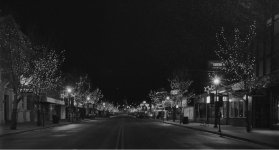Anyone else into night photography?
From a drive to Sunrise on Mt Rainier. It's a 15-minute exposure on Fuji Velvia. I seem to remember having to add two stops for reciprocity shift, which turned a 4-minute exposure into a 15-minute one. 🙂

Seattle viewed from West Seattle.

Tom
From a drive to Sunrise on Mt Rainier. It's a 15-minute exposure on Fuji Velvia. I seem to remember having to add two stops for reciprocity shift, which turned a 4-minute exposure into a 15-minute one. 🙂
Seattle viewed from West Seattle.
Tom
When I got my iphone 12 Promax, I was amazed by its night time hand held image stabilization capability. Here was a shot of 4 planets aligned near the moon on Dec 7, 2021. This was just during a casual walk around my neighborhood. F/1.6 at 1/15th sec exposure ISO 3200.

Here is an image with my iPhone stuck on the eyepiece of a spotting telescope looking at the Orion Nebula:

If you have the Hubble ST, it looks like this😎:

Here is an image with my iPhone stuck on the eyepiece of a spotting telescope looking at the Orion Nebula:
If you have the Hubble ST, it looks like this😎:
Last edited:
Oop. Take that back. It's Seattle viewed from Kerry Park. This is the more common shot from that location (during the day).

Here's Seattle by night from West Seattle (on Contax 645).

Tom
Here's Seattle by night from West Seattle (on Contax 645).
Tom
It can still be with a small distance to the subject!it shouldn't be a big deal
Yes!Anyone else into night photography?
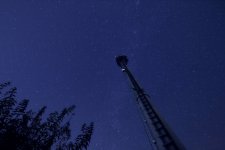
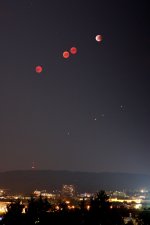
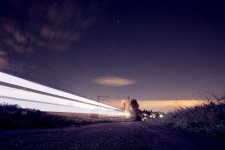
Some multi-exposure photos, including a partual lunar eclipse. (Software-aligned) multi exposure is useful to allow longer exposure times but still avoid linear star-traces. I used "hugins" panorama stiching software to do it.
Night mode for smart phone cameras probably does the same thing.
Last edited:
Not really night, but late evening in winter.Anyone else into night photography?
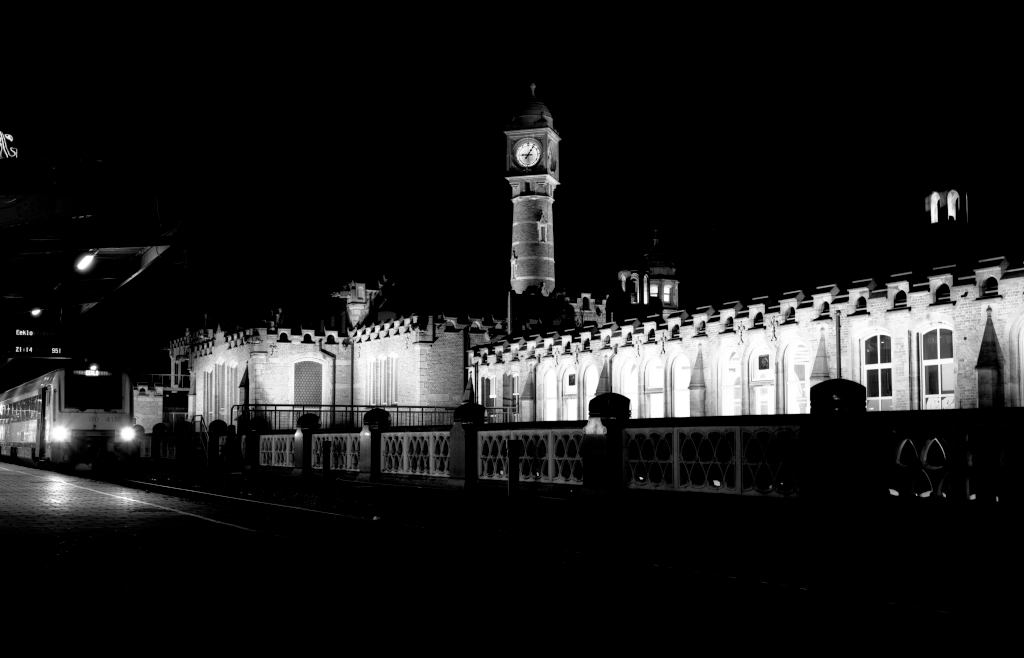
4x5 fujinon W 125mm @ f/11 on fp4+ in microphen. (homeade camera)
Hello everyone, this is my first post here. My website says that I'm a "Technical Photography Expert". I'm also a DIY audio guy. XRK: great idea to start a photo blog here for those who enjoy both audio & photography. There are so many parallels between the two.
I'm excited to see how that 50mm 1.1 works out. If you can find a 25 F/0.95 for $100 bucks, get it. That's an unbelievable deal on the 35mm($17) and I think you are onto something with getting lenses from AliExpress. I'm not a big fan of the Bokeh I'm seeing from that 35mm lens. If you compare it to a swirly Bokeh from a vintage 58mm Carl Zeiss Biotar($300) or the Helios Clone($150) you will see the true swirly & smooth looking Bokeh that I preffer. Also, shooting wide upen might give you a rounder aperture than the blades. A round aperture will have much smoother bokeh.
There's a lot of fun stuff you can do with a small sensor, like adding tilt shift. Using Full Frame lenses on 4/3s is similar to what I do Full Frame Cameras and the lenses are from Meduim Format and 4X5 view cameras.
There's a guy in Romainia who goes by Bokeh Factory on Facebook. He puts mounts and Tile Shift adapters on vintage lenses. I have a Carl Zeiss Biotar 75 1.5 with a Nikon F mount and an 80mm Rusian(Keiv) 6X6 lens on a tilt shift adapter. Fun stuff!
I'm excited to see how that 50mm 1.1 works out. If you can find a 25 F/0.95 for $100 bucks, get it. That's an unbelievable deal on the 35mm($17) and I think you are onto something with getting lenses from AliExpress. I'm not a big fan of the Bokeh I'm seeing from that 35mm lens. If you compare it to a swirly Bokeh from a vintage 58mm Carl Zeiss Biotar($300) or the Helios Clone($150) you will see the true swirly & smooth looking Bokeh that I preffer. Also, shooting wide upen might give you a rounder aperture than the blades. A round aperture will have much smoother bokeh.
There's a lot of fun stuff you can do with a small sensor, like adding tilt shift. Using Full Frame lenses on 4/3s is similar to what I do Full Frame Cameras and the lenses are from Meduim Format and 4X5 view cameras.
There's a guy in Romainia who goes by Bokeh Factory on Facebook. He puts mounts and Tile Shift adapters on vintage lenses. I have a Carl Zeiss Biotar 75 1.5 with a Nikon F mount and an 80mm Rusian(Keiv) 6X6 lens on a tilt shift adapter. Fun stuff!
@StudioMic - please post photos of your Biotar’s swirly bokeh.
Early morning run last year when I was in Toulouse.


iPhone 12 Promax.
25mm F/0.95 lens for M4/3 looks quite nice but is Huge. Also, at $440, it is not a lunch money lens anymore. 😂

Early morning run last year when I was in Toulouse.
iPhone 12 Promax.
25mm F/0.95 lens for M4/3 looks quite nice but is Huge. Also, at $440, it is not a lunch money lens anymore. 😂
Last edited:
Actually, 150 mm on 4x5 is equivalent to 50 mm at 35mm, so it shouldn't be a big deal to get reasonable DOF at f/16.
I think you missed the point completely. It has nothing to do with the f/stop.
In tilting the front standard, it allowed me to adjust the Plane of Focus, Basically, I was using the Scheimpflug principle.
Once I got the focusing point I wanted, then came the f/stop.
My normal shooting aperture for 4x5 is f/16.
I could have shot at f/64 if I wanted.
My Bowens Quad Pack had enough power for that.
But I generally avoid stopping down so much because of the effects of diffraction.
Here's another food shot, this time for Sheraton Hotel.
The assignment came from Ogilvy & Mather Advertising.
In this shoot, not only was the front standard tilted but the back standard was tilted too for perspective control.
Note the verticals in the jar on the left.
Camera was Toyo-View 45G with 6x7 film back.
Lens was Schneider Symmar 150mm f/5.6
Shot on Kodak Ektachrome Professional 64 (EPR64) 120 film.
I use my phone 99% of the time and if I look at the photos I took in Toulouse, I am very happy with how they turned out. But candids of people, I feel there is something about a prime lens with large aperture that’s neat.
The consumer market, yes, probably.destroying the camera market?
Not the professional gear market.
Very good - but most of the improvements come from AI postprocessing, which happens without you noticing it.how good did their quality get
This includes artificial shallow depth of field (with occasional rendering errors), smoothing and color correction of faces (removes red spots), contrast, color and brightness correction etc.
What I like about "old fashioned" cameras is that I can control all of this (or at least I still think I can ...).
A night shot (actually very early in the morning) that I took with one of my 645 cameras on Kodak film. The dawn photo was taken with a cheap Motorola Android phone. Sunrise moments don't last long, so I grabbed what was handy and made the shot.
Attachments
I am impressed what my samsung ultra can do, especially image stabilizing. I took photo of the moon so many times, just by holding cellphone and pointing. It even has crossline zoom in the corner once it understands its a moon.
But no, you will never see professionals using cellphones.
But no, you will never see professionals using cellphones.
Dig a little into the "meta-lens" -- a tuneable lens invented by a fella at Harvard -- he also invented the quantum cascade laser.
Ha! Never say never. The low end camera market is gone, but there are still those of us who recognize the quality of images produced by modern cameras and also older large format tools. IMHO, what will finally destroy the higher end market is not ever better cell cameras, but when nobody cares about or recognizes the quality difference. That's already a very large number of people.I am impressed what my samsung ultra can do, especially image stabilizing. I took photo of the moon so many times, just by holding cellphone and pointing. It even has crossline zoom in the corner once it understands its a moon.
But no, you will never see professionals using cellphones.
I'm not the best, but here's a shot on the way home from work the other day.
Sadly I suspect this is broadly true. I've often thought that digital cameras may have raised the floor yet their effect is also to lower the ceiling.IMHO, what will finally destroy the higher end market is not ever better cell cameras, but when nobody cares about or recognizes the quality difference. That's already a very large number of people.
Here’s a night shot of the Jason-3 mission at liftoff from the Spaceport in French Guyana. I did not take this but it was by a colleague at work.

This was a shot of the earth and moon from a unique vantage point at the sun-earth L1 Lagrange point (100 Million miles away) which always sees the “earth at noon”. Taken by colleagues on the DSCOVR mission using the EPIC camera with 3 RGB color filters on a filter wheel so takes about 40 seconds each then combined to a composite image.

This was a shot of the earth and moon from a unique vantage point at the sun-earth L1 Lagrange point (100 Million miles away) which always sees the “earth at noon”. Taken by colleagues on the DSCOVR mission using the EPIC camera with 3 RGB color filters on a filter wheel so takes about 40 seconds each then combined to a composite image.
Last edited:
